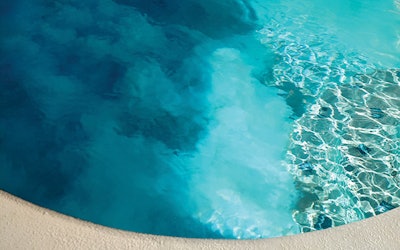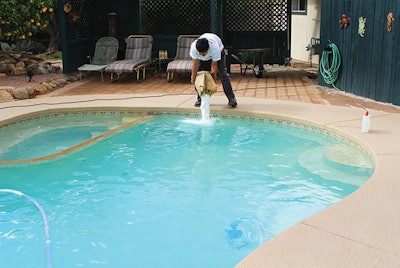
Many of us may have had the unfortunate experience of adding soda ash "wrong" to pool water, resulting in a pool that looks like it is filled with milk. In fact, we refer to it as "milking" a pool. Why does that happen?
When we decide, for example, to raise the pH of a pool from 7.2 to 7.6, we calculate how much soda ash is required for that size pool to achieve a 0.4 pH unit increase. A solution of soda ash (sodium carbonate) has a pH of above 11, so when added to pool water the pH goes up and raises the alkalinity too. But when we figured a dose, that pitcher full of powder is ideally supposed to be immediately distributed throughout the entire pool. When we walk to the shallow end and just dump the entire pitcher-full in a single slug, we may temporarily have a small amount of water, 20 or 30 gallons worth, with a pH in the 10 range.
What does that do to the water? Well, the soda ash is normally very soluble in the water. It goes into solution almost immediately, but it also raises the pH and the saturation index high enough to cause calcium bicarbonate (dissolved calcium in the pool water, or calcium hardness) to precipitate. The white cloud you see is not actually the soda ash, but precipitated calcium carbonate.
RELATED: Key Misunderstandings and Problems in Pool Water Chemistry (Part I)
 When we dump a large slug of soda ash into the pool, we temporarily create a small area of high pH, perhaps in the 10 range, which causes precipitation of calcium carbonate.
When we dump a large slug of soda ash into the pool, we temporarily create a small area of high pH, perhaps in the 10 range, which causes precipitation of calcium carbonate.
If a small amount of calcium carbonate is precipitated producing some cloudiness, it generally and gradually, usually within minutes, re-dissolves and clears up. The added carbonate (from soda ash) blends through the pool, changing and becoming bicarbonates of calcium and sodium, and the pH and the alkalinity rise, as planned. But if too much calcium is precipitated, that can trigger reactions that produce larger particles or crystals that take much longer and are much harder to dissolve back into the rest of the water.
When a pool is milked, we explain the situation to the customer and lay out two choices: We can either re-dissolve the calcium (by lowering the pH using acid until the saturation index value is low enough the calcium carbonate becomes bicarbonate and is re-solubilized) or filter out the precipitate.
The advantage of the first option is that within an hour or two the pool water can be clear again, but with everything (including the calcium!) back where it came from. The advantage of the second is that we have softened the pool (reduced its calcium hardness level), but the pool will be cloudy through the filtration process, which may take days or a week.
Knowing this, of course, means we can soften the customer's pool water and reduce the calcium hardness level, intentionally, by manipulating the water's saturation chemistry using the ion-exchange-style process described above.
The reaction is as follows:
USING SODA ASH:
Adding sodium carbonate to the pool's dissolved calcium hardness (calcium bicarbonate) results in filterable calcium carbonate precipitate and baking soda.

By way of example, we helped a pool owner whose 18,000-gallon pool had a calcium hardness level of 1196 ppm, a pH of 8.2 and a total alkalinity of 180. The pool owner did not want to drain the pool unless they really had to, so they contacted us. We added 70 pounds of soda ash to the pool. This precipitated around 70 pounds of calcium carbonate, which was filtered from the pool. The resultant readings were a calcium hardness level of 589 ppm, a pH of 7.5, and a total alkalinity of 158.
(Using our laboratory analysis equipment, we are able to accurately determine the calcium hardness.)
RELATED: Key Misunderstandings and Problems in Pool Water Chemistry (Part II)
Wait a minute! Shouldn't adding 70 POUNDS of soda ash cause a HUGE increase in pH and alkalinity? Actually, and perhaps surprisingly, no. Since there is an almost one-to one exchange of alkaline materials (sodium carbonate in and calcium carbonate out), the pH and the alkalinity actually stayed about the same.
Caustic soda (sodium hydroxide or NaOH) can be used instead of soda ash to precipitate calcium (which may also precipitate out some magnesium in the water). Less material is required for the same result, but sodium hydroxide may not be available and convenient as the soda ash for most service technicians.
 Before (left) and after (right)
Before (left) and after (right)
USING CAUSTIC SODA:
Adding sodium hydroxide to the pool's dissolved calcium hardness (calcium bicarbonate) results in filterable calcium carbonate precipitate, water and baking soda.

There are variables in how much calcium is precipitated from a given amount of soda ash. These include water temperature (the higher the temperature, the more precipitate), the existing level of calcium and addition method (the more "localized" the addition method, the more precipitate).
Filtering out calcium carbonate can clog some filters pretty quickly. The filter we used was a cartridge-style D.E. unit with no D.E. added. With the customer's suction cleaner plugged into it, it took three days to clear all of the precipitate from the pool, with daily cleanings of the cartridge.
We have found that we can use a simple application of chemistry to save a pool owner from the necessity of draining their pool, and that the calcium carbonate precipitate should not adhere to the pool surface if continually brushed and removed by filtration quickly.











































